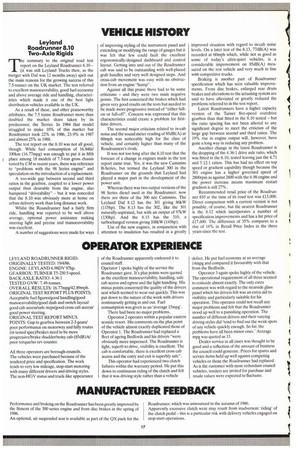VEHICLE HISTORY
Page 133

If you've noticed an error in this article please click here to report it so we can fix it.
Leyland Roadrunner 8.10 Two-Axle Rig ids Roadrunner 8.10 Two-Axle Rig ids The summary to the original road test report on the Leyland Roadrunner 8.10 (it was still Leyland Trucks then, as the merger with Daf was 12 months away) spelt out the main reasons for the growing success of this 7.5-tonner on the UK market. The test referred to excellent manoeuvrability, good fuel economy and above average ride and handling, characteristics which made it one of the best light distribution vehicles available in the UK.
As a result of these, and other praiseworthy attributes, the 7.5 tonne Roadrunner more than doubled the market share taken by its predecessor, the Terrier. In 1984 that model struggled to make 10% of this market but Roadrunner took 22% in 1986, 23.9% in 1987 and almost 25% in 1988.
The test report on the 8.10 was not all good, though. While fuel consumption of 16.84111/ 100km (16.77mpg) was enough to put it in fifth place among 18 models of 7.5-ton gross chassis tested by CM in recent years, there was reference to "problems with the 98 Series engine" and speculation on the introduction of a replacement.
A too-wide gap between second and third ratios in the gearbox, coupled to a lower power output than desirable from the engine, also hampered "driveability" but it was conceded that the 8.10 was obviously more at home on urban delivery work than long distance work.
Whilst the Roundrunner had a fairly firm ride, handling was reported to be well above average, optional power assistance making steering light and precise and manoeuvrability was excellent.
A number of suggestions were made for ways of improving styling of the instrument panel and extending or modifying the range of gauges but it was felt that few could fault the excellent ergonomically-designed dashboard and control layout. Getting into and out of the Roadrunner cab was said to be outstanding with well-placed grab handles and very well designed steps. And cross-cab movement was easy with no obstruction from an engine "hump".
Against all this praise there had to be some criticisms and they were two main negative points. The first concerned the brakes which had given very good results on the tests but needed to be made more progressive instead of "either fullon or full-off". Concern was expressed that this characteristics could create a problem for firsttime drivers.
The second major criticism related to in-cab noise and the sound meter reading of 85dB(A) at 60mph was noticeably high for the class of vehicle, and certainly higher than many of the Roadrunners's rivals.
It was not too long after the 8.10 test that the forecast of a change in engines made in the test report came true. Yes, it was the new Cummins B-Series, but termed the Leyland 300 in the Roadrunner on the grounds that Leyland had played a major part in the development of the power unit.
Whereas there was two output versions of the 98 Series diesel used in the Roadrunner, now there are three of the 300 nee Cummins. The Leyland Daf 8.12 has the 301 giving 86kW (115hp). The 8.13 has the 302, like the 301 naturally-aspirated, but with an output of 97kW (130hp). And the 8.15 has the 310, a turbocharged version giving 108kW (145hp).
Use of the new engines, in conjunction with attention to insulation has resulted in a greatly improved situation with regard to in-cab noise levels. On a later test of the 8.13, 77dB(A) was recorded at 60mph which, while not as good as some of today's ultra-quiet vehicles, is a considerable improvement on 85dB(A) measured on the test vehicle and very much in line with competitive trucks.
Braking is another part of Roadrunner specification which has seen valuable improvements. Front disc brakes, enlarged rear drum brakes and alterations to the actuating system are said to have alleviated or greatly reduced the problems referred to in the test report.
Latest Roadrunners have a higher capacity version of the Turner five-speed overdrive gearbox than that fitted in the 8.10 tested but the ratio spacing has not been altered to any significant degree to meet the criticism of the large gap between second and third ratios. The 19% rise in engine output will, however, have gone a long way in reducing any problem.
Another change in the latest Roadrunner is the dropping of the 4.36:1 drive axle ratio, which was fitted in the 8.10, tested leaving just the 4.71 and 5.12:1 ratios. This has had no effect on top speed or gradient capability though because the 301 engine has a higher governed speed of 2800rpm as against 2600 with the 6.98 engine and the power increase means maximum restart gradient is still 27%.
Recommended retail price of the Roadrunner 810 at the time of its road test was £13,000. Direct comparison with a current version is not possible, of course, but the nearest Roadrunner is the 8.12 which incorporates a number of specification improvements and has a list price of 117,600. The difference of 35% compares to a rise of 16% in Retail Price Index in the three years since the test.




























































































































































































